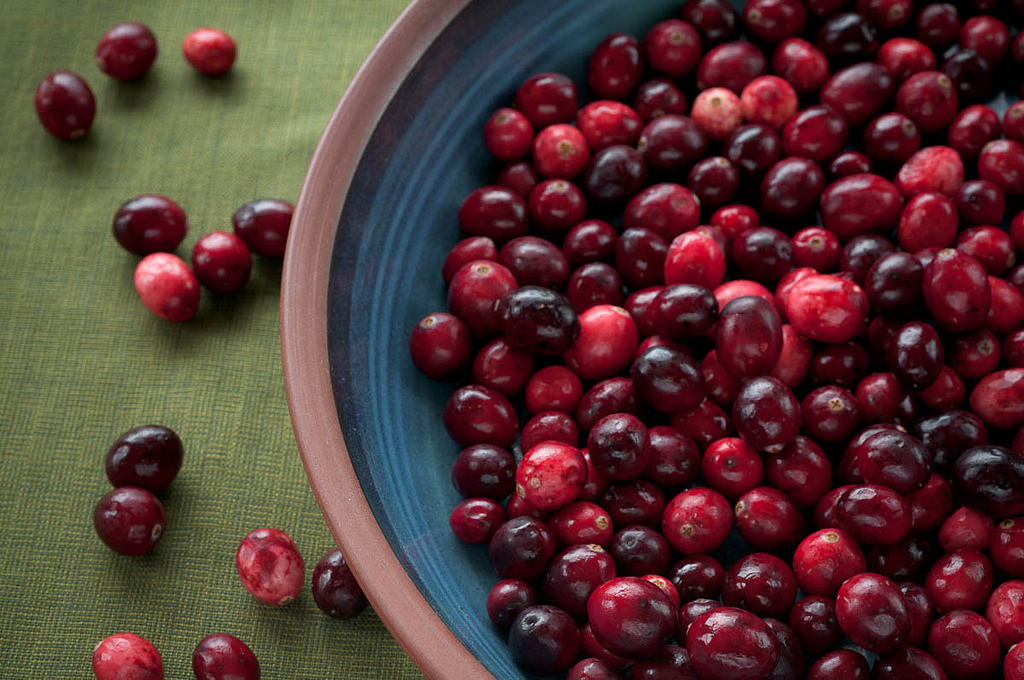
In the Kitchen – Cranberries: A Tale of Sweet and Tart
Holiday
Recipes
Outside of the popular apple, if any fruit could claim the holidays as its own, it would surely be the cranberry. A traditional accompaniment during holiday celebrations, this evergreen shrub indigenous to the northern region of North America makes its debut on grocery store shelves and tables every year when it’s harvested during the fall. It is to turkey what chips are to salsa; what marshmallows are to hot chocolate, and its natural yet tart sweetness and bright color make it a great ingredient for dishes both savory and sweet.
Common Uses
You’ll likely see cranberries largely in cranberry juice or cranberry sauce, but they are great for compotes, pie fillings, scones, breads and muffins. On the savory side, dried cranberries also add texture and subtle sweetness to salads and wraps and sandwiches and can liven up sometimes bland proteins like chicken or pork.
“My favorite thing to do with cranberries is making cranberry apple filling for mini tarts,” says Blue Plate Catering pastry chef. “The process is simple but can taste like it took a lot of work and time when it’s actually only a few ingredients.”
Choosing fresh versus dry berries is key to presentation and flavor, and Harriger recommends using dried cranberries for pastry mixes that you want a sweeter taste or don’t want to risk that “bleeding” look into the dough that can happen from fresh berries. She also suggests using frozen cranberries for the fresh tart flavor and when cooking them down for instance in compotes, pie fillings and sauces. You can also rehydrate dried cranberries by soaking them in a flavored simple syrup and using them as a garnish or sauce on desserts.
Selection
When picking cranberries, look for ones that are slightly opaque with a scarlet red color, and avoid berries that are darker or pale pink which can indicate being over or underripe. The berry should also feel very firm to the touch and should bounce. If they are mushy or soft like a grape, discard. They also freeze well — up to 10-12 months — in their original packaging for any post-Thanksgiving sales.
In the Kitchen
Get creative this holiday season with Chef Harriger’s Cran-Apple compote or Cranberry Poached Pears, below. Make sure to share your inspirations and other dishes with us on Instagram at @blueplatechicago.
Crisp Stuffing Waffles with Confit Chicken, Cranberry Compote and Crispy Sage
Cran-Apple Compote

What you’ll need:
4 cups diced apples
2 cups frozen cranberries
1 cup brown sugar
1 cup granulated sugar
1 tablespoon vanilla paste
1 teaspoon cinnamon
Method:
Place all ingredients in a shallow pot and cook over a low flame approximately 8-10 minutes until the filling is thick, stirring occasionally. The compote also holds up well in the freezer if you want to make ahead and store.
Chef tip: Chef Harriger uses brown sugar for a stronger, sweeter taste but says granulated sugar works just fine. This mix also tends to be juicier and looser than what you would fill a pie that you are going to cut, so if you need a thicker filling continue to reduce the mix or add in cornstarch.
Cranberry Poached Pears

What you’ll need:
8 each Seckel Pears
5 tablespoons honey
3 tablespoons sugar
1 strip orange zest
1 strip lemon zest
4 cups cranberry juice
2¼ cups fresh or frozen cranberries
Method:
Peel pears and place in a saucepan large enough to hold them compactly. Add enough cranberry juice (about 4 cups) to barely cover. Add honey, sugar, orange and lemon zest, and lemon juice. Bring to a boil over medium-high heat, stirring until sugar has dissolved. Reduce heat and simmer until pears are tender when pierced with the tip of the knife, about 10 minutes. Add cranberries and return to simmer until they burst about three minutes. Transfer pears to a large bowl and continue to reduce liquid by half. Chill liquid and pour over them pears. Cover and refrigerate for three days. Discard citrus zest before serving.